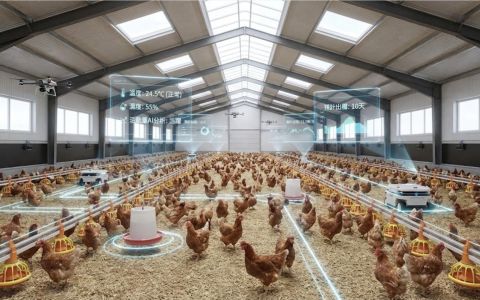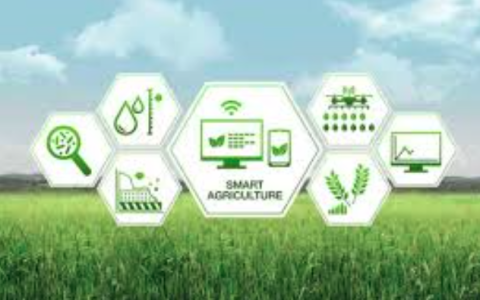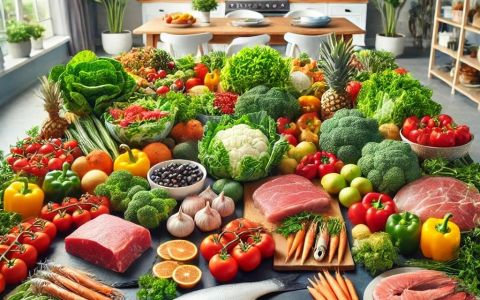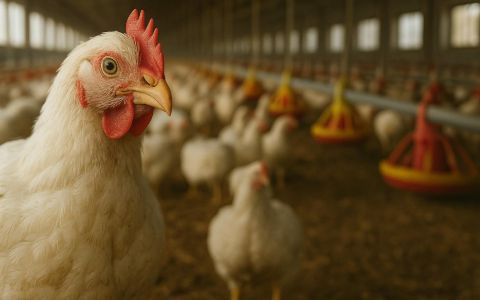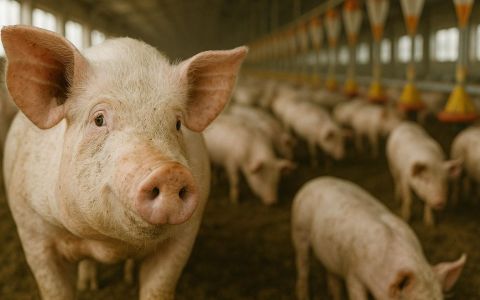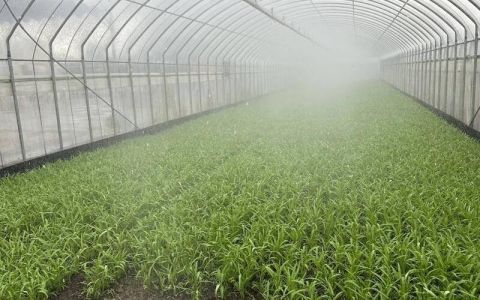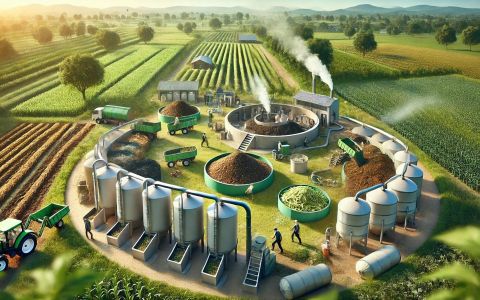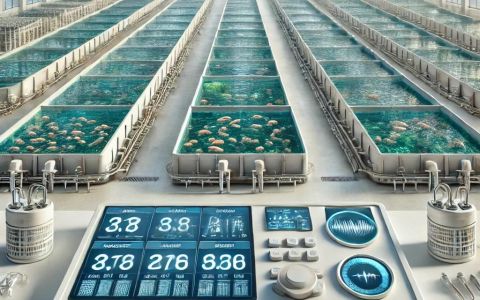Precision Nutrition in Agriculture and Livestock: Leveraging Smart Technology for Sustainable Development
With the global population growing and living standards improving, the demand for agricultural and livestock products continues to rise. However, the traditional agricultural and livestock industries face challenges such as low production efficiency, inefficient resource utilization, and severe environmental pollution. These issues highlight the urgent need for technological innovation to drive industrial upgrades and sustainable development.
Food security and nutrition have become increasingly important concerns, with sustainable agriculture—particularly the livestock industry—playing a critical role in ensuring both. The integration of smart technology presents new opportunities for the agricultural and livestock sectors, especially in the field of precision nutrition. By leveraging smart technology, farmers can gain a more precise understanding of animals' nutritional needs, enhance feed utilization efficiency, reduce waste and environmental impact, and simultaneously improve animal welfare and product quality.
Application of Smart Technology in the Agricultural and Livestock Industry
The application of smart technology in the agricultural and livestock industry spans multiple stages, including production, management, and processing. In Taiwan, the government has launched the "Top Ten Pioneering Industries Smart Agriculture Initiative," prioritizing the development of smart agriculture in sectors such as orchids, seedlings, mushrooms, agricultural facilities, poultry, livestock, aquaculture, rice cultivation, key export crops, and marine fisheries.
Through these initiatives, smart technology helps farmers overcome traditional agricultural challenges while improving overall industry efficiency and sustainability. Below are some examples of how smart technology is being applied in the agricultural and livestock industry:
-
Environmental Monitoring: Sensors and IoT (Internet of Things) technology enable real-time monitoring of environmental parameters in poultry houses or livestock barns, such as temperature, humidity, and ammonia concentration. Automated control systems adjust these conditions to create an optimal growth environment for animals. Precise environmental control helps reduce disease incidence and enhances animal welfare.
-
Automated Feeding: By analyzing factors such as species, age, and growth stage, automated feeding systems calculate precise feed formulas and portion sizes. These systems then dispense feed at scheduled intervals, improving feed utilization efficiency and minimizing waste.
-
Health Monitoring: Image recognition and physiological monitoring technologies allow for real-time tracking of animal health conditions. Early detection of diseases enables timely intervention, reducing morbidity and mortality rates.
-
Feed Additives and Supplements: Research indicates that certain plant extracts—such as artemisinin, bitter ginseng, and quisqualis—enhance animal growth and disease resistance through mechanisms like inhibiting microbial growth or directly eliminating pathogens. Smart technology can optimize the development and application of these plant extracts by precisely controlling extraction processes and monitoring their effects.
-
Production Management: Big data analytics and cloud computing facilitate the analysis of agricultural and livestock production data, optimizing workflows and enhancing management efficiency. Smart technology also improves accuracy in monitoring poultry farming conditions, ensuring better farm management.
-
Robotics and Automation: In the dairy industry, the adoption of automated equipment such as feed-pushing robots, milking robots, and manure-cleaning robots is increasing. These innovations significantly boost milk production while reducing labor costs.
Application of Precision Nutrition in the Agricultural and Livestock Industry
Precision nutrition refers to providing animals with tailored nutritional support based on their individual differences and growth stages to meet their developmental and production needs. In the agricultural and livestock industry, precision nutrition is applied in several key areas:
-
Feed Formula Optimization: By considering factors such as species, age, gender, growth stage, and production performance, optimized feed formulas are designed to enhance feed utilization efficiency and reduce costs.
-
Nutritional Requirement Assessment: Biotechnology and information technology enable precise evaluations of animals' nutritional needs, preventing both deficiencies and excesses. This approach improves overall animal health and enhances productivity.
-
Feeding Strategy Development: Scientific feeding strategies are formulated based on animals' feeding behaviors and metabolic characteristics. Techniques such as phase feeding and time-restricted feeding improve digestion and nutrient absorption efficiency.
-
Online Nutrition Management Systems: Many large feed manufacturers have established online animal nutrition management systems. These systems integrate smart equipment in raw material storage and feed formulation processes, ensuring precise feed production and real-time nutritional adjustments.
How Smart Technology Enhances Precision Nutrition in the Agricultural and Livestock Industry
Smart technology plays a crucial role in precision nutrition by integrating data-driven solutions, automation, and innovative feed technologies. The following are key ways in which smart technology is applied to precision nutrition in the agricultural and livestock industry:
-
Data Collection and Analysis:
Utilizing sensors, IoT (Internet of Things), and other smart technologies, real-time physiological indicators, behavioral data, and environmental conditions are collected and analyzed using machine learning and data analytics. These insights help build animal nutrition models to support precision feeding. For example, sensors can monitor an animal's weight, body temperature, and activity levels, combining this data with environmental factors to assess nutritional needs and adjust feed formulations accordingly. -
Automated Feeding Systems:
By integrating precision nutrition strategies with automated feeding systems, precise feed delivery can be achieved, improving feed utilization and minimizing waste. For instance, automated systems can customize feed composition and portion sizes based on individual animal characteristics and growth stages, ensuring timely and accurate feeding. -
Intelligent Decision Support Systems:
Smart decision support systems use data analytics and expert knowledge to provide farmers with precise nutritional recommendations, such as feed formulation adjustments and feeding strategy optimizations. For example, these systems can analyze growth performance and market trends, advising farmers on the best feed adjustments to minimize costs or enhance production efficiency. -
Innovative Feed and Supplement Technologies:
Biostimulants, which can directly regulate gene expression and alter agronomic traits, have the potential to replace genetically modified crops. Smart technology aids in the development and application of biostimulants by screening for highly effective compounds and optimizing their application methods. This enhances feed nutritional value and improves animal growth and health.
Organizations such as the World's Poultry Science Association Taiwan Branch and the 2024 AI and Animal Health Industry Forum are actively promoting the application of smart technology in precision nutrition, facilitating technical exchanges and advancements in the industry.
Case Studies: Smart Technology Applications in Precision Nutrition for the Agricultural and Livestock Industry
| Case Study | Description | Description |
| Yuan Jin Chuang Enterprise Co., LTD |
Taiwan's integrated duck farming enterprise uses smart technology for precision management, including centralized incubation, gender-based feeding, batch farming, and standardized processing of 85-day-old Tu Ban ducks. |
Production management, quality control |
| Beijing DBN Technology Group |
A Chinese agribusiness developed the "Pig IoT" platform, connecting pig farmers, feed suppliers, slaughterhouses, and financial institutions to form a symbiotic economy. It also introduced "Nong Xin Du," a credit-rating system for pig farmers. |
Data sharing, financial services |
| Cheng Kai Cheng Poultry Cooperative |
A poultry cooperative in Shandong, China, uses smart farming equipment with four automated systems: feeding, egg collection, climate control, and waste management, significantly reducing labor costs. |
Automated production, environmental control |
| AI-Based Dairy Cattle Body Condition Monitoring – Agricultural Technology Research Institute (ATRI) |
Using AI technology, the "3D Dairy Cattle Body Condition Recognition System" accurately and quickly assesses cattle body condition, assisting farmers in herd management. |
Health monitoring, precision feeding |
| Smart Sheep and Goat Breeding Program – Ethiopia |
Ethiopia's Community-Based Breeding Programs (CBBPs) use digital tools (DTREO) for data collection, effectively managing smallholder sheep and goat breeding programs. |
Data management, breed improvement |
Advantages and Challenges of Applying Smart Technology in Precision Nutrition for the Agricultural and Livestock Industry
Advantages
-
Increased Production Efficiency:
Precision nutrition provides optimal nutrition that supports animal growth and development, enhancing both production yield and quality, thus improving overall production efficiency. -
Reduced Production Costs:
By optimizing feed formulations and feeding strategies, precision nutrition improves feed utilization, reduces feed waste, and lowers production costs. -
Improved Animal Welfare:
Precision nutrition ensures that animals’ individual needs are met, improving their health, reducing disease occurrence, and enhancing overall animal welfare. -
Reduced Environmental Pollution:
Precision nutrition minimizes the emission of nutrients from feed, reducing the environmental impact of animal manure and wastewater, thus promoting environmental sustainability.
Challenges
-
Difficulty in Data Collection and Analysis:
Due to significant individual differences among animals, collecting and analyzing physiological and behavioral data can be challenging. -
High Technology Costs:
The application of smart technology requires substantial investment in both technology and implementation. This can be particularly costly for small and medium-sized farms. -
Lack of Skilled Professionals:
Implementing smart technology requires specialized knowledge and skills for operation and maintenance. However, there is currently a shortage of trained professionals in the agricultural and livestock sectors. -
Existing Industry Challenges:
The Taiwan livestock industry faces environmental issues such as wastewater pollution and odor, as well as food safety concerns like residual animal medications and carbon reduction pressures. The application of smart technology must address these challenges in order to foster the sustainable development of the industry.
Future Trends in the Development of Smart Technology for Precision Nutrition in the Agricultural and Livestock Industry
-
More Accurate Nutritional Requirement Assessment:
As biotechnology and information technology continue to advance, future developments will allow for even more precise assessments of animals' nutritional needs. Techniques such as genomics and proteomics will enable a deeper understanding of animal genetics and protein expression, leading to more accurate evaluations of their nutritional requirements. -
Personalized Feeding:
In the future, feeding strategies will be tailored to individual animals based on their specific characteristics. Using sensors and data analytics, farmers will be able to monitor each animal's feeding behavior, growth, and health in real-time. This data will allow for adjustments in feed formulations and feeding amounts based on the individual animal's needs, achieving true personalized feeding. -
Application of Artificial Intelligence and Machine Learning:
Artificial Intelligence (AI) and machine learning will play a crucial role in helping farmers analyze data, predict trends, and optimize decision-making. For instance, machine learning models can be used to forecast animal growth and feed demand, allowing farmers to fine-tune feed formulations and feeding strategies based on predictive insights. AI and machine learning will also enhance the efficiency of feed processing systems, such as extrusion machines and aquaculture feed systems. -
Cross-Disciplinary Collaboration:
The future of precision nutrition in agriculture and livestock will require greater collaboration across various fields, including agriculture, animal husbandry, and information technology. Experts from different disciplines will work together to drive the application of smart technology in precision nutrition. For example, agricultural experts will provide knowledge on animal nutritional needs, livestock specialists will offer insights into animal management, and IT professionals will develop systems and data analytics tools to create more effective precision nutrition solutions.
Conclusion
The application of smart technology has opened new development opportunities for precision nutrition in the agricultural and livestock industries. It can significantly improve production efficiency, reduce costs, enhance animal welfare, and reduce environmental pollution. Additionally, smart technology has boosted farm management efficiency and improved the accuracy of poultry farming environmental monitoring.
As technology continues to advance and its applications deepen, smart technology will play an even greater role in precision nutrition, including more accurate nutritional requirement assessments, personalized feeding strategies, and the use of artificial intelligence and machine learning. These advancements will drive the industry towards greater efficiency and sustainability.
In the future, through cross-disciplinary collaboration and continuous innovation, smart technology will revolutionize traditional livestock farming practices, propelling agriculture towards achieving sustainable development goals.
References
- 家禽產業智慧化推動策略與目標 - 農業部, 檢索日期:1月 22, 2025
- 永續趨勢是推力而非阻力!台灣農畜產業轉型就看現在@ 食力 ..., 檢索日期:1月 22, 2025
- 可持续农业发展促进粮食安全和营养: 畜牧业起何作用?, 檢索日期:1月 22, 2025
- 智農是什麼 - 智慧農業, 檢索日期:1月 22, 2025
- 畜禽產業 - 智慧農業, 檢索日期:1月 22, 2025
- 2023人工智慧和動物健康產業研討會, 檢索日期:1月 22, 2025
- 數位化禽畜營養及數位轉型 - 台灣創新技術博覽會, 檢索日期:1月 22, 2025
- 香港城市大学深圳研究院cityusz, 檢索日期:1月 22, 2025
- 2024臺灣智慧農業週-畜禽暨飼料科技展暨論壇引領精準營養新未來, 檢索日期:1月 22, 2025
- 谯仕彦院士:动物精准营养已成国家战略需求, 檢索日期:1月 22, 2025
- 【智慧科技於農業生產之應用】計畫成果專刊 - Issuu, 檢索日期:1月 22, 2025
- 2024 AI 和動物健康產業論壇 - 臺灣智慧農業週, 檢索日期:1月 22, 2025
- 智慧農業週-畜禽科技展聚焦智慧飼養、成本優化與綠色未來 - 經濟日報, 檢索日期:1月 22, 2025
- 台灣智慧農業現況與需求:家畜家禽篇【2019】, 檢索日期:1月 22, 2025
Other News
This report is based on the 2024 Taiwan Poultry Statistical Manual, published by the Veterinary and Livestock Development Foundation. The following is a quick summary highlighting the key data and development trends of Taiwan's poultry industry in 2024:
Climate change, labour shortages and rising sustainability demands are reshaping agriculture. Here are the key smart farming technologies and trends transforming the sector in 2026.
Taiwan's ready-to-eat agricultural and fishery products and functional foods market is undergoing rapid transformation and growth, primarily driven by modern consumers' high demand for convenience, health, and sustainability. In terms of supply chain, government and private enterprises are heavily investing in automated processing technologies and nationwide cold chain logistics systems to address labor shortages, enhance food safety and quality, and strengthen export competitiveness.
Aquaculture has become a cornerstone of Taiwan's fisheries sector. As of 2023, the industry's production value reached approximately NT$40.2 billion, accounting for nearly 41% of the country's total fisheries output.
Taiwan's poultry industry represents a substantial market opportunity for international equipment manufacturers and technology providers.
Taiwan's livestock production value reaches approximately NT$185.8 billion annually (2021 data), accounting for about 34.6% of the total agricultural output value
Smart irrigation and scheduling tech improve greenhouse farming efficiency in Taiwan, reducing labor needs and increasing productivity.
Taiwan’s agriculture plays a pivotal role in national food security, economic development, and global trade. Despite limited arable land, climate challenges, and an aging rural workforce, Taiwan has developed a highly efficient and technologically advanced agricultural system. Today, the sector is undergoing a digital and sustainable transformation through smart farming, automation, and eco-friendly practices—aimed at boosting productivity, reducing labor reliance, and improving resilience.
Discover how cutting-edge carbon reduction strategies and circular technologies are transforming agriculture, with inspiring examples from Taiwan and Japan leading the way to a greener, more sustainable future.
This innovative approach combines solar photovoltaic power generation with smart aquaculture technologies, enhancing land use efficiency, stabilizing water quality, and improving farming environments to boost productivity and sustainability in the aquaculture industry.









